Step 1: Tour the homes on your short list.
Ask
your discount broker or agent to show you inside
five or six of your top choices. Do this
even if you have your heart set on just one of
them--looking at several alternatives will help
you decide how much to offer and may improve
your bargaining position.
Step 2: Try to
find problems with your top
picks.
Before making
an offer, make sure there's nothing seriously
wrong with the property.
Ask your broker for the following:
-
The disclosure packet (if available).
This will usually be emailed to you as a pdf
file.
-
All previous MLS listings of each property,
with photos. This will tell you, for
example, how much the current owner paid for
it and what upgrades have been made.
Then do the following:
-
Talk to neighbors.
-
In California, visit the
Megan's Law website to see if any
registered sex offenders live nearby
-
If you're buying land, go to the county
planner and discuss zoning restrictions on
the parcel.
-
Call an insurance company to verify that the
home is insurable.
-
If the home is in a risky area, ask
the seller for a
C.L.U.E. (Comprehensive Loss
Underwriting Exchange) report for the
house. This lists all insurance claims that
have been made on the house for the past
five years.
-
If the home is governed by a homeowners
association (HOA), ask about monthly fees
and
CC&Rs. If you're buying a condo or
cooperative unit, ask to see the
association's legal and financial
documents.
-
If you like, you can download
parcel maps and other deed information. In
many western states, you can find a treasure
trove of information at
netronline.com for $3 each. Another
website,
docedge.com, charges $5 per map but
covers a broader area.
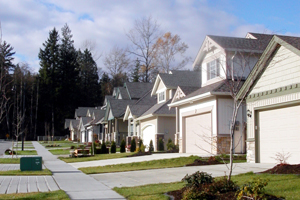 |
Before making an offer on a
house, I like to stroll through the
neighborhood. I invariably find one
or two neighbors outside doing
gardening or unloading groceries.
They almost always give me useful
information. |
Step 3: Estimate the home's market value
If you still want to go ahead with an offer,
you'll need to come up with an offer price.
Start by estimating the home's market value.
To estimate the home's market value, I recommend
that you collect data from various sources:
-
Ask your broker for a comparative market
analysis of the property, showing the prices
paid for properties that have recently sold,
and asking prices for active, withdrawn, and
cancelled listings. Drive by these
properties and look for the best deals.
-
Get a $29.95 Complete Property Valuation
from
electronicappraiser.com.
-
Get free online appraisals of the property
from
Zillow.com,
realestateabc.com, and
Ditech.com.
(On the Ditech website, click on
"Calculators," and then click on "Free
eAppraisal.") These websites don't reveal
their appraisal methodology, but I think
it's based on taking the last sales price
for the property and scaling it upward or
downward according to how average property
prices in the neighborhood have changed. If
the owner has spent a lot of money
remodeling the house, you should fudge the
estimates up accordingly. I found that
Zillow gave fairly good estimates for houses
in subdivisions but poor estimates for
houses with unique attributes, like
custom-built homes on scenic lots. Zillow
allows you to review the details they have
about your home (Click on the "See home
details" link) and edit them.
-
Get information about "comparables"--houses
that are similar to the one you want to buy
that have sold recently.
Zillow.com
and
realestateabc.com are good sources.
(Click the "Map comparable homes" link.) So
is
realestate.yahoo.com (Click on What's My
Home Worth? in the Tools section on the left
hand side.) Create a separate fact sheet
for each comparable, then
drive (or better yet, walk) by all of the
homes and compare them to the one you want.
Try to guess how much more or less your
dream house is worth compared to each of
them, then use these guesses to fudge the
actual sales prices of the comparables into
estimates of your home's market value.
|
Don't
rely too much on online appraisals.
Here are the estimates I got from
some online appraisal services for
four different properties in
California:
A
custom house in the city, last sold
in 1998:
-
Zillow.com: $990,120
-
RealestateABC.com: $958,000
-
Ditech.com: $793,000-$975,000
A
custom house with scenic view on the
coast, last sold in 2002:
-
Zillow.com: $467,007
-
RealestateABC.com: Insufficient
data
-
Ditech.com: $562,000 - $727,000
A
tract home, last sold in 1983:
-
Zillow.com: $492,520
-
RealestateABC.com: $490,000
-
Ditech.com: $515,000 - $595,000
A
tract home, last sold in 2005:
-
Zillow.com: $405,040
-
RealestateABC: $432,000
-
Ditech.com: $405,000 - $498,000
|
|
Other sources won't be of much help,
either. I examined three reports by
certified appraisers that were based
on adjusting the sales prices of
comparables that had sold recently
to account for differences between
them and the subject property. The
adjusted sales prices often varied
by quite a bit:
|
Property
|
Adjusted sales
prices
of comparables |
Appraised value
|
|
#1 |
$717,500
$671,500
$720,000 |
$700,000 |
|
#2 |
$138,500
$148,175
$148,955 |
$148,000 |
|
#3 |
$476,180
$507,380
$541,150 |
$475,000* |
|
*This property had just
sold for $475,000 and
the purpose of the
appraisal was to
reassure the lender that
the price was
reasonable. |
|
Step 4: Figure out what you think the
home's worth
This value may be more or less than the home's
market value, but bear in mind that lenders
sometimes won't approve loans if the sales price
is much higher than the appraised market value.
A good way to figure out what the home is worth
to you is to weigh your alternatives against one
another. Suppose you're interested in a house
on South Street, but you also like a smaller one
on Cable Road. Write down the benefits of the
two choices on a piece of paper. Here's how
your notes might look:
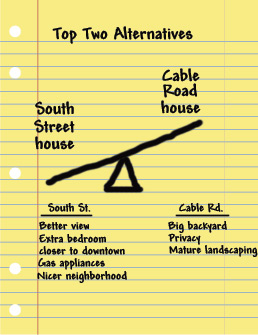
This diagram shows that, to you, the benefits of
the South Street house outweigh those of the
Cable Road house.
Now try to imagine how much money you would need
to add to the Cable Road house in order to make
the two properties equally appealing to you.
For example, if you added $100,000 to the Cable
Road house, would that make it more appealing to
you than the South Street house? Keep testing
different numbers until you come up with a
number that exactly balances the two sides, like
this:
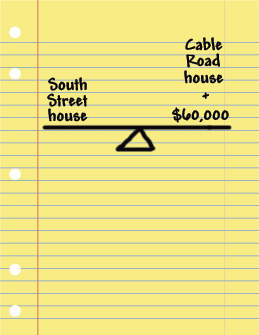
Now guess the market value of the Cable Road
house (say $870,000) and do some algebra. Think
of the balance's fulcrum as an equal sign and
solve for the value of the South Street house.
In this case, the equation would read: South
Street house = Cable Road house + $60,000.
Substituting in your estimate of the price of
the Cable Road house, you'll get a value for the
South Street house of $870,000 + $60,000 =
$930,000.
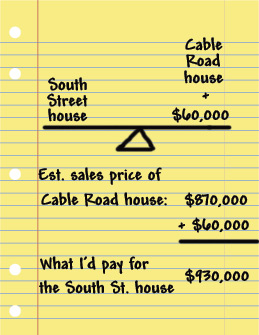
The sum, $930,000, gives you an estimate of the
maximum price you should pay for the South
Street house, based on the assumption that you
could buy the Cable Road house for $870,000.
Do
the same exercise with your other options.
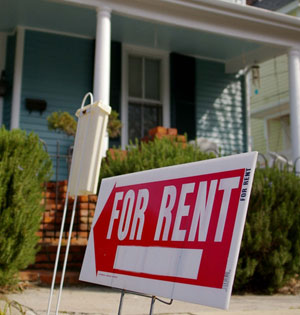 |
When deciding how much a house is
worth to you, consider renting as an
option.
See
The Buy vs. Rent Decision by
Suze Orman for
help in thinking this through. |
Step 5:
Consider your bargaining position
My husband is a good negotiator, but it's
agonizing to watch him in action. He sometimes
starts low--really low. The buyer's agent (or
car salesperson) invariably looks crestfallen.
I don't say anything during these negotiations,
but I always feel ashamed and
embarrassed. After wasting hours or even days
of the salesperson's time, we're finally
revealing ourselves to be flaky and unrealistic.
But we often end up getting terrific deals.
 |
Buyers' agents will often act
disappointed or annoyed if you want
to make a low offer. Pay no
attention. |
Of course, we don't always make low offers.
Once, we even made a full-price offer with no
contingencies on a lot that we absolutely had to
have. There were no other lots like it and we
were afraid we'd lose it to another buyer.
Whether or not you can start low depends on the
strength of your bargaining position. Here are
some factors that would give you a strong
bargaining position:
-
If the house has been on the market for a
long time.
-
If there are other, similar houses in the
neighborhood.
-
If you're likely to be able to close the
deal in a timely manner.
-
If you're interested in more than one house.
-
If you're in no hurry to buy a house.
If your bargaining position is weak, it will be
harder to get a good deal. That's why it's a
good idea to strengthen your position before you
begin negotiations. One way to do this is to
sell your existing home before you begin
searching for a replacement. Another is to go a
mortgage lender and get pre-approved for a loan
so you can demonstrate your ability to buy the
house. Finally, you should look at lots of
houses and try to find several that are
acceptable to you.
Step 5:
Decide on an offer price
Sellers usually set their asking price about
1-10% above their estimate of its market value.
But sellers can get that wrong, and they're
sometimes willing to accept offers that are well
below the asking price.
If your bargaining position is very strong, try
subtracting 10% from either your estimate of the
market value or the asking price--whichever is
lower. Suppose, for example, the asking price
was $950,000 and your estimate of the home's
market value was $920,000. I'd recommend that
you consider a starting offer of $830,000 (which
is roughly 90% of $920,000). Before making this
offer, verify that the offer falls below your
lowest estimate of what the house is worth to
you ($910,000 in our example). If it doesn't,
lower it.
If your bargaining position is weak, or if the
housing market is hot in your area, you'll
probably want to make an offer that's much
closer to the asking price. And if the market
is very hot, you may want to make an offer
that's above the asking price.
Next step:
Making an offer.
ŠLori Alden, 2008. All rights reserved.
|

